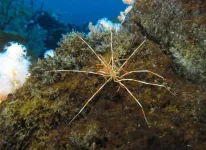(Press-News.org) A rapid scoping review has been conducted which reveals five common ways in which the health of homeless pet owners and their companion animals is improved.
Ten percent of homeless people keep pets. But little information exists on specific intervention strategies for improving the health of homeless people and their pets who are often the only source of unconditional love or companionship in their life.
The study, published in the Human-Animal Interactions journal, found that the most common ways in which homeless people are their pets are supported to live healthier lives include free veterinary clinics, join human/animal clinics, stigma reduction, interdisciplinary relationships, and pet-friendly lodging.
Lead authors Dr Michelle Kurkowski and Dr Andrew Springer said research on homeless people and their pets showed significant heterogeneity, but they stress that further programme intervention is needed to recommend intervention best practices.
Promising avenues for evaluating interventions and improving health
They suggest that joint human/animal clinics and interdisciplinary partnerships are promising avenues for evaluating interventions and improving health outcomes.
A study by Ramirez et al (2022) that investigated 44 homeless pet owners in Seattle, USA, for example, found that 61% of respondents were interested in healthcare for their pets, compared to 43% for themselves. Furthermore, 86% indicated they would attend a joint veterinary/human health clinic, with convenience frequently mentioned.
Studies that the researchers drew upon for their findings – from the PubMed and Embase databases – include those focused on homeless pet owners across the USA, Canada, and the UK.
Dr Kurkowski wrote the paper while at the University of Texas Health Science Center at Houston School of Public Health (UTHealth) but is now a Veterinary Medical Officer for the USDA Animal and Plant Health Inspection Service.
A source of friendship and physical safety
She said, “Research has shown that companion animals are a source of friendship and physical safety, and homeless persons with pets report significantly lower rates of depression and loneliness compared to non-pet owners.
“Studies show that pet owners experiencing homelessness are also subjected to unique challenges in caring for both themselves and their companion animals. Individuals, for instance, are often forced to choose between accessing lodging and keeping their pets with them.
“Similarly, our review reveals that this group is less likely to utilize needing assistance, such as healthcare or career services, potentially due to difficulty using public transportation of lack of safe places to leave pets.”
However, Dr Kurkowski and Dr Springer said that despite the growing body of literature on both the benefits of pet ownership for the unhoused community – as well as the needs and challenges that homeless pet owners and their pets face – little attention has been given to developing interventions to address the challenges facing this group.
More comprehensive and effective care package
Dr Springer, associate professor of in the Department of Health Promotion and Behavioral Sciences at the UTHealth, “Our purpose was to describe the study designs, measurements, and outcomes of relevant primary research studies to identify knowledge gaps in the body of literature on this topic.
“Additionally, common intervention characteristics were highlighted to create a ‘road map’ of prior interventions to assist individuals interested in creating similar programs.
“The ultimate goal of this assessment was to summarize key intervention strategies for pet owners experiencing homelessness to help direct future funding, research, and outreach efforts among this unique population.”
The researchers conclude that a more comprehensive and effective care package for homeless people and their pets will require the combined efforts of healthcare providers, social workers, animal welfare workers and governmental and nonprofit organizations to develop innovative One Health solutions for the challenges currently facing this population.
Full paper reference
Kurkowksi, M., Springer, A, ‘Exploring Strategies for Pet Owners Experiencing Homelessness: A Rapid Scoping Review,’ Human-Animal Interactions, 19 February (2024). DOI: 10.1079/hai.2024.0002
The paper can be read open access from 10:00hrs UK time 19 February 2024, here: https://www.cabidigitallibrary.org/doi/10.1079/hai.2024.0002
Media enquiries
For more information and an advance copy of the paper contact:
Dr Michelle Kurkowski, Veterinary Medical Officer for the USDA Animal and Plant Health Inspection Service, michelleakurkowski@gmail.com
Wayne Coles, Senior PR Manager, CABI – email: w.coles@cabi.org
About Human—Animal Interactions
Human—Animal Interactions is an open access interdisciplinary journal devoted to the dissemination of research in all fields related to interactions between non-human animals and their human counterparts.
About CABI
CABI is an international not-for-profit organization that improves people’s lives by providing information and applying scientific expertise to solve problems in agriculture and the environment.
Through knowledge sharing and science, CABI helps address issues of global concern such as improving global food security and safeguarding the environment. We do this by helping farmers grow more and lose less of what they produce, combating threats to agriculture and the environment from pests and diseases, protecting biodiversity from invasive species, and improving access to agricultural and environmental scientific knowledge. Our 49-member countries guide and influence our core areas of work, which include development and research projects, scientific publishing, and microbial services.
We gratefully acknowledge the core financial support from our member countries (and lead agencies) including the United Kingdom (Foreign, Commonwealth and Development Office), China (Chinese Ministry of Agriculture and Rural Affairs), Australia (Australian Centre for International Agricultural Research), Canada (Agriculture and Agri-Food Canada), Netherlands (Directorate-General for International Cooperation, and Switzerland (Swiss Agency for Development and Cooperation). Other sources of funding include programme/project funding from development agencies, the fees paid by our member countries and profits from our publishing activities which enable CABI to support rural development and scientific research around the world.
END
Study reveals five common ways in which the health of homeless pet owners and their companions is improved
A rapid scoping review has been conducted which reveals five common ways in which the health of homeless pet owners and their companion animals is improved. Ten percent of homeless people keep pets. But little information exists on specific interventions
2024-02-19
ELSE PRESS RELEASES FROM THIS DATE:
Potassium depletion in soil threatens global crop yields
2024-02-19
Potassium deficiency in agricultural soils is a largely unrecognised but potentially significant threat to global food security if left unaddressed, finds new research involving researchers at UCL, University of Edinburgh and the UK Centre for Ecology & Hydrology.
The study, published in Nature Food, found that more potassium is being removed from agricultural soils than is being added, throughout many regions of the world. It also gives a series of recommendations for how to mitigate the issue.
Potassium is a vital nutrient for plant growth that ...
Poorly coiled frog guts help scientists unravel prevalent human birth anomaly
2024-02-19
How does our intestine, which can be at least 15 feet long, fit properly inside our bodies? As our digestive system grows, the gut tube goes through a series of dramatic looping and rotation to package the lengthening intestine. Failure of the gut to rotate properly during development results in a prevalent, but poorly understood, birth anomaly called intestinal malrotation. Now, in a study published in the journal Development, scientists from North Carolina State University have uncovered a potential cause of this life-threatening condition.
Intestinal malrotation affects 1 in 500 births but the underlying causes are not well understood. ...
Unveiling uremic toxins linked to itching in hemodialysis patients
2024-02-19
Niigata, Japan – Dr. Yamamoto et al. found the several uremic toxins as one of causes of itching in hemodialysis patients. Hemodialysis patients commonly experience itching on a daily basis, which is distributed throughout their bodies. They developed a "PBUT score" based on highly protein-bound uremic toxins (PBUT) that increase in the body with end-stage kidney disease. The PBUT score was associated with itching in hemodialysis patients.
I. Background of the Study
Patients with advanced chronic kidney disease (CKD) require kidney replacement therapy, such as hemodialysis, to manage their condition. Hemodialysis patients often experience various symptoms, ...
Communities must get prepared for increased flooding due to climate change, expert warns
2024-02-19
Communities must be better prepared for flooding in their homes and businesses, an expert warns, as climate change predictions suggest more extreme flooding globally.
Floods still inflict major costs to the economies, livelihoods and wellbeing of communities, with flood risks and impacts set to increase further due to climate change (IPCC, 2021).
Professor of Environmental Management, Lindsey McEwen explains how many experts now believe local communities have critical roles as key actors within flood risk management and disaster risk reduction.
Professor McEwen, author of Flood ...
Giant Antarctic sea spiders reproductive mystery solved by UH researchers
2024-02-18
Link to video and sound (details below): https://spaces.hightail.com/receive/JwM0o5gQdq
The reproduction of giant sea spiders in Antarctica has been largely unknown to researchers for more than 140 years, until now. University of Hawaiʻi at Mānoa scientists traveled to the remote continent and saw first-hand the behaviors of these mysterious creatures, and their findings could have wider implications for marine life and ocean ecosystems in Antarctica and around the world.
Sea spiders, or ...
This tiny, tamper-proof ID tag can authenticate almost anything
2024-02-18
A few years ago, MIT researchers invented a cryptographic ID tag that is several times smaller and significantly cheaper than the traditional radio frequency tags (RFIDs) that are often affixed to products to verify their authenticity.
This tiny tag, which offers improved security over RFIDs, utilizes terahertz waves, which are smaller and travel much faster than radio waves. But this terahertz tag shared a major security vulnerability with traditional RFIDs: A counterfeiter could peel the tag off a genuine item and reattach it to a fake, and the authentication system would be none the wiser.
The researchers have now surmounted ...
Viruses that can help ‘dial up’ carbon capture in the sea
2024-02-17
DENVER – Armed with a catalog of hundreds of thousands of DNA and RNA virus species in the world’s oceans, scientists are now zeroing in on the viruses most likely to combat climate change by helping trap carbon dioxide in seawater or, using similar techniques, different viruses that may prevent methane’s escape from thawing Arctic soil.
By combining genomic sequencing data with artificial intelligence analysis, researchers have identified ocean-based viruses and assessed their genomes to find that they “steal” genes from other microbes or cells that process carbon in the sea. Mapping microbial ...
Imageomics poised to enable new understanding of life
2024-02-17
Embargoed until 1:30 p.m. ET, Saturday Feb. 17, 2024
DENVER – Imageomics, a new field of science, has made stunning progress in the past year and is on the verge of major discoveries about life on Earth, according to one of the founders of the discipline.
Tanya Berger-Wolf, faculty director of the Translational Data Analytics Institute at The Ohio State University, outlined the state of imageomics in a presentation on Feb. 17, 2024, at the annual meeting of the American Association for the Advancement of Science.
“Imageomics ...
Scientists try out stone age tools to understand how they were used
2024-02-17
Tokyo, Japan – Researchers from Tokyo Metropolitan University crafted replica stone age tools and used them for a range of tasks to see how different activities create traces on the edge. They found that a combination of macroscopic and microscopic traces can tell us how stone edges were used. Their criteria help separate tools used for wood-felling from other activities. Dated stone edges may be used to identify when timber use began for early humans.
For prehistoric humans, improvements in woodworking technology were revolutionary. While Paleolithic (early stone age) artifacts point to the use of wood for simple tools such as spears ...
Combating fractional spurs in phase locked loops to improve wireless system performance in Beyond 5G
2024-02-17
Two innovative design techniques lead to substantial improvements in performance in fractional-N phase locked loops (PLLs), report scientists from Tokyo Tech. The proposed methods are aimed to minimize unwanted signals known as fractional spurs, which typically plague PLLs used in many modern radar systems and wireless transceivers. These efforts could open doors to technological improvements in wireless communication, autonomous vehicles, surveillance, and tracking systems in beyond 5G era.
Many emerging and evolving technologies, such as self-driving vehicles, target tracking systems, and remote sensors, rely on the high-speed and error-free operation ...
LAST 30 PRESS RELEASES:
Interaction of climate change and human activity and its impact on plant diversity in Qinghai-Tibet plateau
From addressing uncertainty to national strategy: an interpretation of Professor Lim Siong Guan’s views
Clinical trials on AI language model use in digestive healthcare
Scientists improve robotic visual–inertial trajectory localization accuracy using cross-modal interaction and selection techniques
Correlation between cancer cachexia and immune-related adverse events in HCC
Human adipose tissue: a new source for functional organoids
Metro lines double as freight highways during off-peak hours, Beijing study shows
Biomedical functions and applications of nanomaterials in tumor diagnosis and treatment: perspectives from ophthalmic oncology
3D imaging unveils how passivation improves perovskite solar cell performance
Enriching framework Al sites in 8-membered rings of Cu-SSZ-39 zeolite to enhance low-temperature ammonia selective catalytic reduction performance
AI-powered RNA drug development: a new frontier in therapeutics
Decoupling the HOR enhancement on PtRu: Dynamically matching interfacial water to reaction coordinates
Sulfur isn’t poisonous when it synergistically acts with phosphine in olefins hydroformylation
URI researchers uncover molecular mechanisms behind speciation in corals
Chitin based carbon aerogel offers a cleaner way to store thermal energy
Tracing hidden sources of nitrate pollution in rapidly changing rural urban landscapes
Viruses on plastic pollution may quietly accelerate the spread of antibiotic resistance
Three UH Rainbow Babies & Children’s faculty elected to prestigious American Pediatric Society
Tunnel resilience models unveiled to aid post-earthquake recovery
Satellite communication systems: the future of 5G/6G connectivity
Space computing power networks: a new frontier for satellite technologies
Experiments advance potential of protein that makes hydrogen sulfide as a therapeutic target for Alzheimer’s disease
Examining private equity’s role in fertility care
Current Molecular Pharmacology achieves a landmark: real-time CiteScore advances to 7.2
Skeletal muscle epigenetic clocks developed using postmortem tissue from an Asian population
Estimating unemployment rates with social media data
Climate policies can backfire by eroding “green” values, study finds
Too much screen time too soon? A*STAR study links infant screen exposure to brain changes and teen anxiety
Global psychiatry mourns Professor Dan Stein, visionary who transformed mental health science across Africa and beyond
KIST develops eco-friendly palladium recovery technology to safeguard resource security
[Press-News.org] Study reveals five common ways in which the health of homeless pet owners and their companions is improvedA rapid scoping review has been conducted which reveals five common ways in which the health of homeless pet owners and their companion animals is improved. Ten percent of homeless people keep pets. But little information exists on specific interventions





